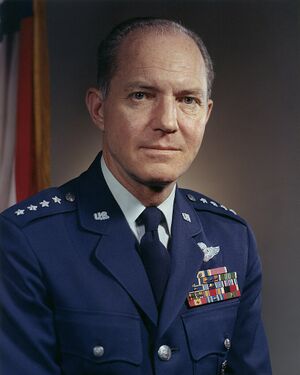Difference between revisions of "Samuel C. Phillips"
(Added: birth_date, birth_place, death_date, death_place.) |
(unstub) |
||
| Line 2: | Line 2: | ||
|constitutes=spook | |constitutes=spook | ||
|wikipedia=https://en.wikipedia.org/wiki/Samuel_C._Phillips | |wikipedia=https://en.wikipedia.org/wiki/Samuel_C._Phillips | ||
| + | |description=USAF officer who led [[Apollo program]] and then the [[National Security Agency]]. | ||
|birth_date=February 19, 1921, U.S. | |birth_date=February 19, 1921, U.S. | ||
|birth_place=Springerville, Arizona, U.S. | |birth_place=Springerville, Arizona, U.S. | ||
|death_date=January 31, 1990 | |death_date=January 31, 1990 | ||
|death_place=Palos Verdes, California, U.S. | |death_place=Palos Verdes, California, U.S. | ||
| + | |alma_mater=University of Wyoming,University of Michigan | ||
| + | |image=Gen Samuel C. Phillips, color portrait.jpg | ||
|employment={{job | |employment={{job | ||
|title=Director of the National Security Agency | |title=Director of the National Security Agency | ||
| Line 12: | Line 15: | ||
}} | }} | ||
}} | }} | ||
| + | '''Samuel Cochran Phillips''' was a [[United States Air Force]] general who was Director of [[NASA]]'s [[Apollo program]] from 1964 to 1969, commander of the [[Space and Missile Systems Organization]] (SAMSO) from 1969 to 1972, the seventh [[Director of the National Security Agency|Director]] of the [[National Security Agency]] from 1972 to 1973, and commander of the [[Air Force Systems Command]] from 1973 to 1975. | ||
| + | |||
==Career== | ==Career== | ||
| − | + | A 1942 graduate of the [[University of Wyoming]], Phillips was commissioned in the Army through the [[Reserve Officers Training Corps]]. He transferred to the [[US Army Air Corps|Army Air Corps]], qualified as a fighter pilot, and flew two tours of duty in [[World War II]] with the [[Eighth Air Force]]'s [[364th Fighter Group]]. After the war he was an electronics officer during [[Operation Greenhouse]] [[nuclear weapon test]]s at [[Eniwetok Atoll]], and served in project officer assignments with the [[Boeing B-52 Stratofortress]] heavy bomber, [[AIM-4 Falcon]] [[air-to-air missile]], and [[CIM-10 Bomarc|Bomarc]] [[surface-to-air missile]] programs. He helped negotiate the agreement with the United Kingdom for the [[Project Emily|deployment and use]] of the American [[PGM-17 Thor|Thor]] nuclear-armed [[intermediate-range ballistic missile]]s. In 1958, he was assigned to the [[Air Force Ballistic Missile Division]] of the [[Air Research and Development Command]], as the Director of the [[LGM-30 Minuteman|Minuteman]] [[Intercontinental Ballistic Missile]] (ICBM) Program. As such, he oversaw the first deployments of Minuteman missiles in 1962.<ref name=USAF/> | |
| + | |||
| + | In 1964, Phillips was seconded to NASA as the director of the [[Apollo program]]. He brought in [[USAF|Air Force]] personnel to fill project management positions. The Apollo program's mission was done in July 1969, and Phillips returned to the Air Force.<ref name=USAF/> | ||
| + | |||
| + | In September 1969, Phillips assumed command of the [[Space and Missile Systems Organization]] (SAMSO), of the Air Force Systems Command in [[Los Angeles]]. In August 1972, he was appointed the seventh [[Director of the National Security Agency]] (DIRNSA) and the Chief of the [[Central Security Service]]. After two years in those positions, he was assigned as the commander of the Air Force Systems Command at [[Andrews Air Force Base]], [[Maryland]], in August 1973. He retired from the Air Force in 1975 as a general.<ref name=USAF>https://www.af.mil/About-Us/Biographies/Display/Article/105961/general-samuel-c-phillips/</ref> | ||
| + | |||
| + | |||
{{SMWDocs}} | {{SMWDocs}} | ||
==References== | ==References== | ||
{{Reflist}} | {{Reflist}} | ||
| − | |||
Revision as of 04:16, 24 January 2024
(spook) | ||||||||||||||
|---|---|---|---|---|---|---|---|---|---|---|---|---|---|---|
 | ||||||||||||||
| Born | February 19, 1921, U.S. Springerville, Arizona, U.S. | |||||||||||||
| Died | January 31, 1990 (Age 68) Palos Verdes, California, U.S. | |||||||||||||
| Alma mater | University of Wyoming, University of Michigan | |||||||||||||
USAF officer who led Apollo program and then the National Security Agency.
| ||||||||||||||
Samuel Cochran Phillips was a United States Air Force general who was Director of NASA's Apollo program from 1964 to 1969, commander of the Space and Missile Systems Organization (SAMSO) from 1969 to 1972, the seventh Director of the National Security Agency from 1972 to 1973, and commander of the Air Force Systems Command from 1973 to 1975.
Career
A 1942 graduate of the University of Wyoming, Phillips was commissioned in the Army through the Reserve Officers Training Corps. He transferred to the Army Air Corps, qualified as a fighter pilot, and flew two tours of duty in World War II with the Eighth Air Force's 364th Fighter Group. After the war he was an electronics officer during Operation Greenhouse nuclear weapon tests at Eniwetok Atoll, and served in project officer assignments with the Boeing B-52 Stratofortress heavy bomber, AIM-4 Falcon air-to-air missile, and Bomarc surface-to-air missile programs. He helped negotiate the agreement with the United Kingdom for the deployment and use of the American Thor nuclear-armed intermediate-range ballistic missiles. In 1958, he was assigned to the Air Force Ballistic Missile Division of the Air Research and Development Command, as the Director of the Minuteman Intercontinental Ballistic Missile (ICBM) Program. As such, he oversaw the first deployments of Minuteman missiles in 1962.[1]
In 1964, Phillips was seconded to NASA as the director of the Apollo program. He brought in Air Force personnel to fill project management positions. The Apollo program's mission was done in July 1969, and Phillips returned to the Air Force.[1]
In September 1969, Phillips assumed command of the Space and Missile Systems Organization (SAMSO), of the Air Force Systems Command in Los Angeles. In August 1972, he was appointed the seventh Director of the National Security Agency (DIRNSA) and the Chief of the Central Security Service. After two years in those positions, he was assigned as the commander of the Air Force Systems Command at Andrews Air Force Base, Maryland, in August 1973. He retired from the Air Force in 1975 as a general.[1]